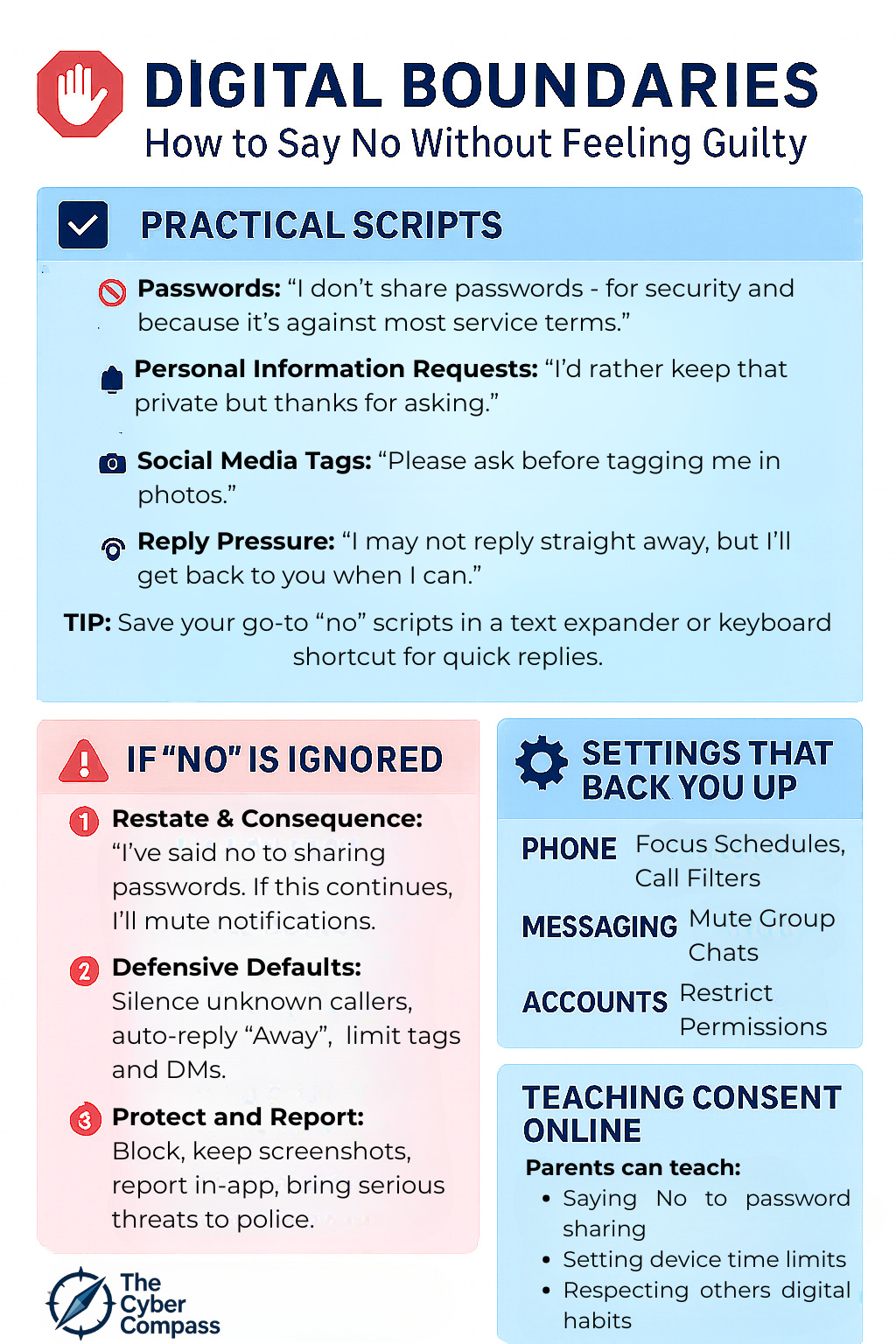🛑 Digital Boundaries: How to Say No Online Without Feeling Guilty
Your guide to protecting privacy, confidence, and consent in the digital age
It starts small.
A friend asks for your Netflix password.
A colleague keeps messaging after hours.
A stranger on Instagram wants more personal info than you’re comfortable giving.
We often feel pressured to say yes online—because saying no feels rude, awkward, or “too much.”
But here’s the truth:
Boundaries online are as important as locks on your doors.
And you have the right to set them—without guilt.
💬 Why We Struggle With Saying No Online
Social pressure: We don’t want to upset friends, family, or colleagues
Apps nudge us: Notifications keep popping up until we respond
Blurred lines: Work, school, and social life all share the same devices and feeds
Fear of conflict: Saying no can feel like rejecting the person, not just the request
But healthy digital boundaries don’t push people away—
they protect your energy, privacy, and peace of mind.
🧭 Practical Ways to Say No (Without the Guilt)
Here are copy-paste scripts you can adapt to fit your style.
Password sharing (friend):
🙅 “I don’t share passwords—for security and because the service terms forbid it. Thanks for understanding!”After-hours messages (boss/client):
⏰ “I log off at 6pm to protect focus. I’ll reply in the morning. If urgent, please call.”Oversharing requests (colleague/stranger):
🔒 “I keep that private, but thanks for asking.”Social media tags (friends/family):
📸 “Please ask before tagging me in photos or posts.”Pressure to reply instantly (group chats):
📱 “I reply within 24 hours. If it’s time-sensitive, add URGENT to the subject.”Documents over chat (landlord/school):
📂 “For privacy I don’t share IDs over WhatsApp. Please use email or the secure portal.”Repeat asks:
🛑 “I’ve answered this already. Please don’t ask again.”
🚦 If Your “No” Isn’t Respected
A boundary without consequences is just a wish.
Restate + consequence
→ “I’ve said no to sharing passwords. If this continues, I’ll mute this chat.”Reduce exposure
→ Mute for 8h/1 week; restrict DMs; silence unknown callers; hide read receipts.Protect & report
→ Block, report in-app, and keep screenshots. For harassment or threats, escalate to the platform and, if necessary, local authorities.
(Safety note: if you ever feel unsafe, prioritise your wellbeing and seek support offline too.)
🧩 The Boundary Stack (Settings That Back You Up)
Pair polite words with strong defaults:
Phone (iOS/Android): Focus/DND schedules, silence unknown callers, disable lock-screen previews
Messaging: WhatsApp disappearing messages, restrict mentions/tags, mute noisy groups
Email: Delay send after hours, auto-reply for “focus time”
Accounts: Password manager, 2FA, separate email aliases for finance, family, newsletters
These small toggles reinforce your words—so your boundaries hold even when you’re busy.
🛡️ Teaching Teens (and Ourselves) the Language of Consent
For parents and educators, digital boundaries are a chance to teach consent in everyday life:
Saying no to password sharing = the same skill as saying no to bigger pressures later
Setting time limits online shows the value of rest, privacy, and focus
Respecting someone else’s boundary builds empathy and reciprocity
Boundaries aren’t rejection. They’re respect in practice.
🌱 Neuro-Inclusive Boundaries
Not everyone is comfortable with confrontation—or has the energy for it.
Low-spoon script: “I’m offline now. I’ll reply when I have the energy.”
Buffer tool: Use keyboard shortcuts/text expanders with pre-saved “no” responses.
Written boundaries: Pin your communication hours in your bio, signature, or status.
Boundaries can be gentle, automated, or written down—and still valid.
📸 Boundaries Around Photos & Location
Two extra areas to remember:
Photos: “Please ask before posting my photo, and avoid tagging my location.”
Location: “I don’t share live location. I’ll text when I’m on my way.”
🍿 Real-Life Scenario
Teenager: “Can I have your login for Spotify Premium?”
Friend: “Sorry, I don’t share accounts. It’s a rule I’ve set for myself.”
The conversation moves on. The friendship remains intact. The boundary stands.
Sometimes the only drama is the one we create in our heads.
📌 TL;DR — Digital Boundaries 101
Saying no online = self-respect, not selfishness
Clear, polite scripts work better than over-explaining
Parents & educators can model digital consent daily
Pair boundaries with device settings (“Boundary Stack”)
Boundaries protect time, energy, and trust
Final Thought: Saying No Is Saying Yes—to Yourself
In the physical world, we lock doors, draw curtains, and say “not now.”
Online, we need the same habits.
Boundaries aren’t barriers.
They’re invitations to healthier, safer, more respectful connections.
So the next time your instinct says no—say it.
And remember: clarity is kinder than silence.
✍️ Heather Roache
Founder, The Cyber Compass
Navigate the Digital World with Confidence
📎 Free Resource: Digital Boundaries Infographic
📚 References
NCSC UK – Password Guidance & 2FA
ICO – Data Minimisation & Privacy
Netflix ToS – Account Sharing Rules
WhatsApp – Privacy & Safety Features



